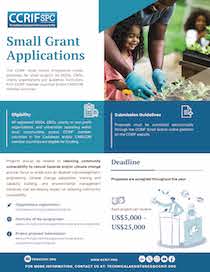CCRIF SPC is the Caribbean and Central America Parametric Insurance Facility and Development Insurer. It is the world's first multi-country, multi-peril risk pool based on parametric insurance and the leading provider of parametric insurance for Caribbean and Central American governments, as well as electric utility companies and water utilities. CCRIF offers parametric insurance for tropical cyclones, excess rainfall, earthquakes, and the fisheries and electric and water utilities sectors – insurance products not readily available in traditional insurance markets.
In 2007, the Caribbean Catastrophe Risk Insurance Facility was formed as a regional catastrophe fund for Caribbean governments to limit the financial impact of devastating hurricanes and earthquakes by quickly providing financial liquidity when a policy is triggered.
In 2014, the facility was restructured into a segregated portfolio company (SPC) to facilitate expansion into new products and geographic areas and is now named CCRIF SPC. The new structure, in which products are offered through a number of segregated portfolios, allows for total segregation of risk. In April 2015, CCRIF signed an MOU with COSEFIN - the Council of Ministers of Finance of Central America, Panama and the Dominican Republic - to enable Central American countries to formally join the Facility.
CCRIF SPC is registered in the Cayman Islands and operates as a virtual organisation, supported by staff members and a network of service providers covering the areas of risk management, risk modelling, captive management, reinsurance, reinsurance brokerage, asset management, technical assistance, corporate communications and information technology.
CCRIF offers 6 parametric insurance products – for tropical cyclones, earthquakes, excess rainfall, and the electric and water utilities and fisheries sectors. Also, a 7th product – for fluvial flooding – is being offered to select countries for 2025/26.
CCRIF helps to mitigate the short-term cash flow problems small developing economies suffer after major natural disasters. CCRIF’s parametric insurance mechanism allows it to provide rapid payouts to help members finance their initial disaster response and maintain basic government functions after a catastrophic event.
CCRIF has 35 members
- 19 Caribbean governments: Anguilla, Antigua and Barbuda, Barbados, Belize, Bermuda, British Virgin Islands, Cayman Islands, Dominica, Grenada, Haiti, Jamaica, Montserrat, St. Kitts and Nevis, St. Lucia, Sint Maarten, St. Vincent and the Grenadines, The Bahamas, Trinidad and Tobago, Turks and Caicos Islands
- 4 Central American governments: Guatemala, Honduras, Nicaragua, Panama
- 4 Caribbean electric utility companies: ANGLEC (Anguilla), DOMLEC (Dominica), GRENLEC (Grenada), and LUCELEC (Saint Lucia)
- 7 Caribbean water utilities: BWS (Belize), CWSA (The Bahamas), DOWASCO (Dominica), MUL (Montserrat), NAWASA (Grenada), WASCO (Saint Lucia), and WSC (The Bahamas)
- 1 tourist attraction: Cayman Turtle Conservation and Education Centre
Since the inception of CCRIF in 2007, the Facility has made 82 payouts totalling approximately US$483 million. Also, CCRIF has made 29 payments totalling approximately US$4 million under member governments’ Aggregated Deductible Cover (ADC) endorsement on their tropical cyclone or earthquake policies. CCRIF has made payments totalling approximately US$3.4 million under member governments’ Wet Season Trigger (WST) and Localized Event Trigger (LET) endorsements on their excess rainfall policies, respectively.
The ADC endorsement for tropical cyclone and earthquake policies was introduced in the 2017/2018 policy year. The ADC was designed to be akin to a dedicated reserve fund providing a minimum payment for events that are objectively not sufficient to trigger a CCRIF policy, because the modelled loss is below the attachment point.
The WST endorsement for excess rainfall policies was introduced for the 2024/25 policy year. It was designed to provide a payout for rainfall incidents occurring amidst already saturated soil conditions and therefore is able to capture the heightened risk of flooding and landslides under such conditions.
The policy payouts and ADC and WST enodrsements are shown in the tables below.
CCRIF was developed under the technical leadership of the World Bank and with a grant from the Government of Japan. It was capitalized through contributions to a Multi-Donor Trust Fund (MDTF) by the Government of Canada, the European Union, the World Bank, the governments of the United Kingdom and France, the Caribbean Development Bank and the governments of Ireland and Bermuda, as well as through membership fees paid by participating governments.
In 2014, the Central America and Caribbean Catastrophe Risk Insurance Program (CACCRIP) MDTFwas established by the World Bank to support the development of CCRIF SPC’s new products for current and to facilitate the entry for Central American countries and additional Caribbean countries. The MDTF currently channels funds from various donors, including: Canada, through Global Affairs Canada; the United States, through the Department of the Treasury; the European Union, through the European Commission; and Germany, through the Federal Ministry for Economic Cooperation and Development and KfW. Additional financing has been provided by the Caribbean Development Bank, with resources provided by Mexico; the Government of Ireland; and the European Union through its Regional Resilience Building Facility managed by the Global Facility for Disaster Reduction and Recovery (GFDRR) and The World Bank. Additional financing has been provided by the Caribbean Development Bank (CDB), with resources provided by Mexico; the Government of Ireland; and the European Union through its Regional Resilience Building Facility managed by the Global Facility for Disaster Reduction and Recovery (GFDRR) and the World Bank. In 2024, CCRIF received funding from CDB, through the Canada-CARICOM Climate Adaptation Fund, to enable seven CCRIF members to increase their coverage and make their national social protection systems more shock responsive.
Current Members:
Nineteen Caribbean governments: Anguilla, Antigua & Barbuda, Bahamas, Barbados, Belize, Bermuda, British Virgin Islands, Cayman Islands, Dominica, Grenada, Haiti, Jamaica, Montserrat, St. Kitts & Nevis, Saint Lucia, Sint Maarten, St. Vincent & the Grenadines, Trinidad & Tobago and Turks & Caicos Islands. Four Central American governments: Guatemala, Honduras, Nicaragua, and Panama. Four electric utility companies: ANGLEC, GRENLEC, LUCELEC, and DOMLEC. Seven water utility companies: BWS (Belize), CWSA (The Bahamas),DOWASCO (Dominica), MUL (Montserrat), NAWASA (Grenada), WASCO (Saint Lucia), and WSC (The Bahamas). One tourist attraction: Cayman Turtle Conservation and Education Centre.
|
Event |
Country Affected |
Payouts (US$) |
|---|---|---|
|
Earthquake, 29 November 2007 |
Dominica |
528,021 |
|
Saint Lucia |
418,976 |
|
|
Tropical Cyclone Ike, September 2008 |
Turks and Caicos Islands |
6,303,913 |
|
Earthquake, 12 January 2010 |
Haiti |
7,753,579 |
|
Tropical Cyclone Earl, August 2010 |
Anguilla |
4,282,733 |
|
Tropical Cyclone Tomas, October 2010 |
Barbados |
8,560,247 |
|
Saint Lucia |
3,241,613 |
|
|
St Vincent & the Grenadines |
1,090,388 |
|
|
Tropical Cyclone Gonzalo, October 2014 |
Excess Rainfall Policy - Anguilla | 493,465 |
|
Trough System, 7-8 November 2014
|
Anguilla | 559,249 |
| St. Kitts & Nevis | 1,055,408 | |
|
Trough System, 21 November 2014 |
Barbados | 1,284,882 |
|
Tropical Storm Erika, 27 August 2015 |
Excess Rainfall policy - Dominica | 2,402,153 |
|
Earthquake, June 9, 2016 |
Nicaragua | 500,000 |
|
Tropical Cyclone Earl, August 2016 |
Excess Rainfall policy - Belize | 261,073 |
|
Tropical Cyclone Matthew, September 2016 |
Barbados |
975,000 |
Excess Rainfall policy - Barbados |
753,277 | |
Excess Rainfall policy - Saint Lucia |
3,781,788 | |
Excess Rainfall policy - St. Vincent & the Grenadines |
285,349 | |
| Tropical Cyclone Matthew, October 2016 |
Haiti |
20,388,067 |
|
Excess Rainfall policy - Haiti |
3,020,767 | |
|
Tropical Cyclone Otto, November 2016 |
Nicaragua | 1,110,193 |
|
Tropical Cyclone Irma, September 2017
|
St. Kitts and Nevis |
2,294,603 |
Anguilla |
6,529,100 | |
Excess Rainfall policy - Anguilla |
158,823 | |
Antigua & Barbuda |
6,794,875 | |
Turks & Caicos Islands |
13,631,865 | |
|
Excess Rainfall policy - Turks & Caicos Islands |
1,232,769 | |
Excess Rainfall policy - The Bahamas |
163,598 | |
|
Tropical Cyclone Maria, September 2017
|
Dominica |
19,294,800 |
Excess Rainfall policy - Dominica |
1,054,022 | |
Excess Rainfall policy - Saint Lucia |
671,013 | |
Turks & Caicos islands |
419,372 | |
Excess Rainfall policy - Barbados |
1,917,506 | |
Excess Rainfall policy - St. Vincent & the Grenadines |
247,257 | |
|
Rainfall event, October 18-20 2017 |
Excess Rainfall policy - Trinidad | 7,007,886 |
Tropical Storm Kirk, October 2018 |
Excess Rainfall policy - Barbados | 5,813,299 |
Rainfall event, October 18-20 2018 |
Excess Rainfall policy - Trinidad | 2,534,550 |
| Tropical Cyclone Dorian, September 2019 | Tropical Cyclone policy - The Bahamas |
11,527,151 |
Excess Rainfall policy - The Bahamas |
1,297,002 | |
Tropical Cyclone Karen, October 2019 |
Excess Rainfall policy - Tobago | 362,982 |
Tropical Cyclone Amanda/Cristobal, May/June 2020 |
Excess Rainfall policy - Belize | 203,136 |
Tropical Cyclone Amanda/Cristobal, May/June 2020 |
Excess Rainfall policy - Guatemala | 3,628,013 |
Tropical Cyclone Laura, August 2020 |
Excess Rainfall policy - Haiti | 7,163,958 |
Rainfall Event, August 31 - September 2, 2020 |
Excess Rainfall policy - Tobago | 176,146 |
Tropical Cyclone Zeta/Eta, October/November 2020 |
Excess Rainfall policy - Jamaica | 3,500,000 |
| Tropical Cyclone Eta, November 2020 |
Excess Rainfall policy - Panama |
2,670,556 |
Tropical Cyclone Eta, November 2020 |
Tropical Cyclone policy - Nicaragua | 7,793,524 |
Tropical Cyclone Eta, November 2020 |
Excess Rainfall policy - Nicaragua | 2,956,021 |
Tropical Cyclone Iota, November 2020 |
Tropical Cyclone policy - Nicaragua | 19,891,162 |
Tropical Cyclone Elsa, July 2021 |
Tropical Cyclone policy - Barbados | 1,345,500 |
Tropical Cyclone Elsa, July 2021 |
Excess Rainfall policy - Barbados | 1,124,424 |
| Earthquake, August 14, 2021 |
Haiti |
39,953,272 |
| Rainfall Event, August 18 - 20, 2021 |
Excess Rainfall policy - Trinidad |
2,381,464 |
| Rainfall Event, September 17-19, 2022 |
Excess Rainfall policy - Antigua & Barbuda |
420,645 |
| Rainfall Event, October 5 - 8, 2022 |
Excess Rainfall policy - Trinidad |
5,115,782 |
| Rainfall Event, October 5 - 8, 2022 |
Excess Rainfall policy - Tobago |
726,932 |
| Tropical Cyclone Julia, October 8, 2022 |
Nicaragua |
8,924,577 |
| Rainfall event, November 26-28, 2022 |
Excess Rainfall policy - Trinidad |
1,400,000 |
| Tropical Cyclone Lisa, November 2022 |
Belize |
455,000 |
| Tropical Cyclone Phillippe, October 2023 |
Excess Rainfall policy - Antigua & Barbuda |
2,880,424 |
|
Tropical Cyclone Phillippe, October 2023 |
Excess Rainfall policy - British Virgin Islands | 552,297 |
|
Tropical Cyclone Tammy, November 2023 |
Excess Rainfall policy - St. Kitts & Nevis | 1,509,804 |
|
Earthquake, December 9, 2023 |
British Virgin Islands | 849,374 |
|
Rainfall event, June 13 - 19, 2024 |
Excess Rainfall - Guatemala | 6,376,184 |
|
Tropical Cyclone Beryl, July 2024 |
St. Vincent & the Grenadines | 1,862,728 |
|
Tropical Cyclone Beryl, July 2024 |
Grenada | 42,425,110 |
|
Tropical Cyclone Beryl, July 2024 |
Excess Rainfall - Grenada | 548,850 |
|
Tropical Cyclone Beryl, July 2024 |
COAST - Grenada | 1,066,667 |
|
Tropical Cyclone Beryl, July 2024 |
Electric Utilities - GRENLEC - Grenada | 9,323,276 |
|
Tropical Cyclone Beryl, July 2024 |
CWUIC - NAWASA - Grenada | 2,201,833 |
|
Tropical Cyclone Beryl, July 2024 |
Tobago | 372,752 |
|
Tropical Cyclone Beryl, July 2024 |
Jamaica | 16,309,185 |
|
Tropical Cyclone Beryl, July 2024 |
Excess Rainfall - Jamaica | 10,278,754 |
|
Tropical Cyclone Beryl, July 2024 |
Cayman Turtle Conservation and Education Centre |
119,474 |
|
Rainfall event, October 31 – November 4, 2024 |
Excess Rainfall - Panama |
7,599,765 |
|
Rainfall event, October 31 – November 4, 2024 |
Excess Rainfall - Panama (FAP) | 19,100,504 |
|
Rainfall event, November 14 - 19, 2024 |
Excess Rainfall - Honduras | 4,665,090 |
|
Tropical Cyclone Imelda, October 2025 |
The Bahamas, Central | 448,096 |
| Tropical Cyclone Imelda, October 2025 | The Bahamas, South East | 849,781 |
| Tropical Cyclone Melissa, October 2025 | Jamaica | 70,803,832 |
| Tropical Cyclone Melissa, October 2025 | Excess Rainfall - Jamaica | 21,085,860 |
|
Total for the period June 2007 - October 2025 |
|
483,062,366 |
|
Total for Tropical Cyclone policy |
277,589,641 | |
|
Total for Earthquake policy |
50,003,222 | |
|
Total for Excess Rainfall policy |
142,877,727 | |
|
Total for COAST (fisheries) |
1,066,667 | |
| Total for Electric Utilities | 9,323,276 | |
|
Total for CWUIC (water utilities) |
2,201,833 | |
|
Total for Tourist Attraction |
119,474 | |
Total for TC/EQ ADC |
4,192,774 | |
Total XSR WST |
3,438,691 | |
Total LET |
1,198,434 |






